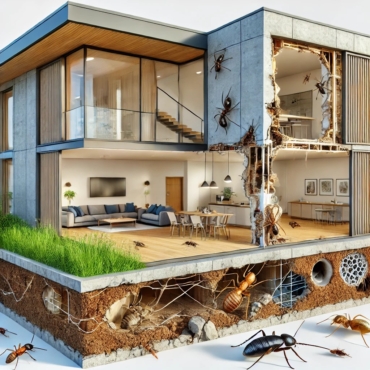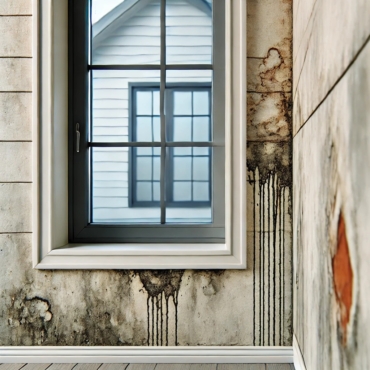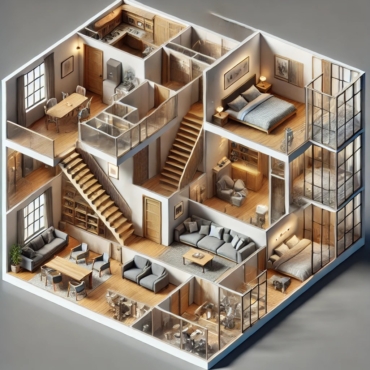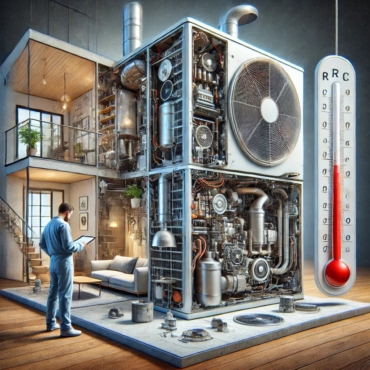Building a home is an exciting and significant investment, but it comes with its share of challenges. From the initial planning stages to the final touches, many things can go wrong if not properly managed. Understanding the common pitfalls in home construction can help you avoid costly mistakes and ensure your dream home becomes a reality. This blog post will delve into the issues of insects, molds, insulation problems, roof problems, wrong room disposition, and other potential pitfalls.
1. Insects and Pest Infestation
Termites
Termites are one of the most destructive pests when it comes to home construction. They can silently and efficiently destroy wood structures, causing severe damage before they are even noticed. To prevent termite infestation, use termite-resistant materials and ensure the foundation and wood are treated with appropriate chemicals.

Ants and Rodents
Ants and rodents can also cause significant damage to a new home. Ants can infiltrate walls and foundations, while rodents can chew through electrical wiring and insulation. Sealing all entry points and maintaining a clean construction site can help mitigate these issues.
Preventive Measures
- Use treated wood for framing and foundations.
- Seal cracks and crevices in the foundation and walls.
- Keep the construction site clean and free of debris.
- Schedule regular pest inspections during and after construction.
2. Mold and Mildew
Causes of Mold
Mold can quickly become a problem in new constructions, especially in areas with high humidity or poor ventilation. Leaks, condensation, and improper insulation can create the perfect environment for mold growth.mold 
Health Risks
Mold can cause various health issues, including respiratory problems, allergies, and skin irritation. It’s essential to address mold issues promptly to protect the health of the home’s occupants.
Preventive Measures
- Ensure proper ventilation in all areas, especially bathrooms and kitchens.
- Use mold-resistant materials in construction.
- Fix leaks and water damage immediately.
- Maintain proper humidity levels inside the home.
3. Insulation Problems
Importance of Proper Insulation
Proper insulation is crucial for maintaining a comfortable indoor temperature and reducing energy costs. Inadequate or poorly installed insulation can lead to drafts, uneven heating, and higher utility bills.
Common Insulation Issues
- Gaps and voids in insulation.
- Incorrect installation techniques.
- Using the wrong type of insulation for specific areas.
Preventive Measures
- Choose the right type of insulation for each part of the house.
- Hire experienced professionals for installation.
- Conduct a thorough inspection to ensure all areas are properly insulated.
4. Roof Problems
Leaks and Water Damage
A poorly constructed roof can lead to leaks, which can cause significant water damage to the interior of the home. Common causes of roof leaks include improper flashing, damaged shingles, and inadequate slope.
Structural Issues
Incorrectly designed or constructed roofs can suffer from structural problems, such as sagging or collapsing. This can be caused by using substandard materials or poor workmanship.
Preventive Measures
- Use high-quality roofing materials.
- Ensure proper installation by experienced professionals.
- Regularly inspect and maintain the roof to catch and repair issues early.
5. Wrong Room Disposition
Impact on Livability
The layout and disposition of rooms can significantly impact the livability and functionality of a home. Poorly planned layouts can lead to awkward spaces, inefficient traffic flow, and reduced natural light.
Common Layout Mistakes
- Placing bedrooms next to noisy areas like the living room or kitchen.
- Inadequate storage space.
- Poorly positioned windows that don’t maximize natural light.
Preventive Measures
- Work with an experienced architect or designer to create an efficient and functional layout.
- Consider the lifestyle and needs of the future occupants.
- Ensure ample storage and proper room positioning for natural light and privacy.
6. Foundation Issues
Causes of Foundation Problems
Foundation issues can arise from poor soil conditions, inadequate site preparation, or improper construction techniques. These problems can lead to cracks, settling, and structural instability.
Preventive Measures
- Conduct a thorough soil analysis before construction.
- Use appropriate foundation materials and techniques.
- Ensure proper drainage around the foundation to prevent water accumulation.
7. Plumbing and Electrical Issues
Common Plumbing Problems
- Leaks and water pressure issues.
- Poor drainage and sewer backups.
- Inadequate water heater capacity.
Common Electrical Problems
- Overloaded circuits and frequent tripping.
- Insufficient outlets and lighting.
- Poorly installed wiring leading to fire hazards.
Preventive Measures
- Hire licensed and experienced plumbers and electricians.
- Use high-quality materials and adhere to building codes.
- Conduct thorough inspections and testing before finalizing the construction.
8. HVAC System Problems
Importance of a Proper HVAC System
A properly installed HVAC system is essential for maintaining indoor air quality and comfort. Issues with the HVAC system can lead to poor air circulation, uneven heating or cooling, and increased energy costs.
Common HVAC Issues
- Incorrect sizing of the system.
- Poor installation leading to leaks and inefficiency.
- Inadequate maintenance and cleaning.
Preventive Measures
- Ensure proper sizing and installation by experienced professionals.
- Regularly maintain and clean the HVAC system.
- Use high-quality components and materials.
9. Poor Finishing and Detailing
Impact on Aesthetics and Functionality
Poor finishing and detailing can detract from the overall aesthetics and functionality of a home. Issues like uneven paint, poorly installed fixtures, and substandard materials can affect the home’s value and livability.
Common Finishing Problems
- Inconsistent paint coverage and color.
- Gaps and uneven seams in trim and molding.
- Low-quality materials that wear quickly.
Preventive Measures
- Hire skilled contractors for finishing work.
- Use high-quality materials and paints.
- Conduct a thorough inspection to ensure all details are properly executed.
10. Regulatory and Compliance Issues
Importance of Compliance
Ensuring compliance with local building codes and regulations is crucial for the safety and legality of the construction. Non-compliance can lead to fines, delays, and even the need for costly modifications.
Common Regulatory Issues
- Failure to obtain necessary permits.
- Non-compliance with zoning laws.
- Ignoring safety and accessibility requirements.
Preventive Measures
- Work with knowledgeable professionals who understand local regulations.
- Obtain all necessary permits before beginning construction.
- Adhere to all building codes and safety standards.
Conclusion
Building a home is a complex process that requires careful planning and execution. By being aware of these common pitfalls and taking preventive measures, you can significantly reduce the risk of encountering major issues during construction. Proper planning, hiring experienced professionals, and regular inspections are key to ensuring your dream home becomes a reality without unnecessary complications. But awareness is not enough. People do mistakes. The only reliable prevention are checklists. Checklists are responsible for safe air travel. For a few dollars for a home construction checklist, why not make sure your house is built safely too?
